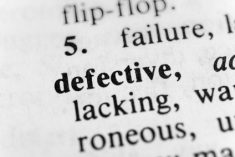
What is a Health, Safety aPrévisualiser les modifications (s’ouvre dans une nouvelle fenêtre)nd Environment (HSE) “type”? You’re probably not alone in asking this, so read on.
This article follows on from my post about the outdated HSE Maturity Model, and is my proposed alternative. I will outline each HSE Type, why determining this matters for businesses, and how HSE “typing” works for businesses and HSE.
The HSE Maturity Model: A Quick Recap

The HSE Maturity Model seems to have emerged as a management consulting self-assessment tool. It allows companies to place themselves on a progression chart, qualifying their current HSE performance as well as gaps the organisation needs to fill in order to advance.
I feel it’s an outdated, one-size-fits-all checklist approach that completely miscategorises and misdefines what mature and immature HSE management looks like, as well as how HSE evolves within an organisation over time. In short, I don’t believe it’s fit-for-purpose.
What are “HSE Types”?
“HSE Types” is my own concept based on my HSE experience. It is the type of organisational HSE a company chooses and commits to achieving. It is the company’s vision, in collaboration with key stakeholders, of what HSE success looks like for them. In short, an organisation’s HSE Type reflects its HSE aspirations.
This is different to the HSE Strategy. Formalising the HSE Type sets the framework within which HSE can then construct a fit-for-purpose strategy and mission to fulfil that mutually agreed aspiration. As this is achieved, or as the organisation matures, the company may choose to revisit its HSE Type.
Because HSE Types are aspirational, business performance might not immediately meet this forward-looking target. Externally stating one HSE Type as the company’s target, but internally framing another is a misapplication of the system. So too is aiming to progress from one type to another, although legitimate examples may exist linked in notable business change.
With regards the Maturity Model, there are three main differences between it and HSE Types. First, the latter has a defined business-integration “progression target” or endpoint. Second, that target (HSE success) is agreed within the business—which should have obvious advantages for genuine HSE integration. Third, targeting the “middle” HSE Type (integration) is perfectly acceptable.
Why Businesses Should Care
Besides choosing its own HSE success and targeting that endpoint—vs. the ever-onwards, third-party defined maturity model mentality—there are other business benefits. Knowing the endpoint and level of HSE integration allows the business to determine upfront its HSE resourcing prerequisites necessary to achieving success. This avoids later what the business might view as scope and budget creep over time, especially if incident rates are artificially low due to a defective HSE system.
Once agreed, HSE has an operational and budgetary framework within which to build its strategy. In short, choosing your organisational HSE Type is about setting a SMART HSE strategy that has no surprises and which delivers for the business.
The business might just get the HSE that it asks for—so choosing wisely and in proportion to its operations is essential.
Choosing an HSE Type: Does this Mean HSE is a Negotiation?

Organisational health, safety and environment is non-negotiable. Besides the LESE business benefits, some aspects are legal requirements. What is negotiable in my opinion is whether the business wishes to go beyond effective HSE and to be an HSE leader.
The six HSE Types revolve around this key word: effective. At the lower end of the Type spectrum, HSE is viewed as disruptive and with little or negative business value. At the leadership end, businesses regard “world class” HSE (and typically corporate social responsibility) as a worthwhile and business-differentiating activity. The negotiation is for the business to determine which type it benefits from best.
The six HSE Types outlines a complete model—from defective to effective to differentiated HSE—intended to help businesses and HSE managers develop an HSE strategy that is fit-for-purpose for their chosen type.
Defective HSE: Types One to Three

The first three HSE Types fall into the defective category of HSE management approaches. Ultimately, in my opinion, each is bound to fail in HSE’s core mission to protect enterprise from damage or loss, people from injury and death, and environment from impact.
Lip Service HSE
As the name suggests, HSE is an insincere afterthought. It is almost entirely reactive. Although it may not be explicitly stated internally—and especially not externally—the business has zero aspiration to have anything but a token approach to HSE.
The only “preventative actions” might be to mask unsafe conditions or behaviours ahead of audits or authority inspections. Another might be senior management’s efforts to curtail personal impacts (being fined, sacked or imprisoned) when serious incidents inevitably occur. This might involve “tweaking” HSE incident numbers, directly or through reporting definitions—if such metrics are even collected in a meaningful way. Legal non-compliance is ignored, hidden, or superficially rectified.
HSE budgets are likely to be rock-bottom as the understaffed function is viewed as an operating cost. Incident avoidance is probably due to a combination of worker high risk tolerance—they know the risks but work in a self-preservative manner—and chance. This type, therefore, does not necessarily have multiple fatalities, but it will very likely have a considerable number of unreported incidents of all other severities. It will have very little valuable HSE learnings or continual improvement.
Compliant HSE
The directive for this Type is to meet “minimum requirements”—that is bare bones legal compliance with applicable HSE regulations. Effective HSE remains an afterthought to employees and the organisation.
In many ways, consistent HSE compliance is a victory because it is difficult to maintain. Also, compliance does, to some degree, help prevent incidents. However, in all likelihood, the operational mind-set will be to try just hard enough to meet this goal and, in practice, compliance will be on paper only. Inspections (if undertaken) will find non-compliant situations, particularly in out of the way places on site. In part, this is due to unchecked poor HSE behaviours where it is “easier” to mask issues than to correct them.
Given the hard legal line between being compliant and non-compliant, and no real organisational effort to exceed this “minimum requirement”, the business will fail to meet even this low target of compliance just as often as they succeed.
Systems HSE
The organisation may or may not have achieved compliance with all applicable HSE regulations, but there is at least genuine effort by parts of the business to do so. There is, however, an over-reliance on paper-based systems and controls. HSE might be described as “desk-bound” rather than practical—a recipe for failure.
Because the approach to HSE risk control is for HSE to make for itself a new cabinet filing section, audit discussions with non-HSE employees will yield rambling responses that make little sense. HSE systems, policies, and procedures may be superficially strong. Non-HSE employees probably know very little about these documents, their contents, or HSE in general other than how to do their job in an unsafe workplace, largely with under-reported minor incidents.
Serious incident numbers may still be low as people play a “definition” game to demote severities and so keep headline numbers down. This mind-set might be exacerbated by rewards for zero incidents—a practice that puts downward pressure on incident reporting and learnings. As a result, near misses and less-serious incidents resulting in lost work time for the company may consistently be zero or near-zero even if this doesn’t match reality.
Genuine embedding of HSE within the organisation is not a goal (despite, perhaps, hollow policy and management statements to the contrary) and will never be realised.
Integrated HSE: Type Four

This category comprises a single HSE Type where HSE is an effective, proactive business consideration and force.
It is possible to subdivide this Type into three separate developmental categories: Engagement, Involvement, and Integration. Engagement is where HSE is leading on this activity with non-HSE colleagues. Involvement is where non-HSE colleagues proactively seek this from HSE.
As it is, all three terms are adequately summed up by the Type’s aspirational HSE goal: Integration.
HSE Integration
HSE is, for the most part, embedded within the organisation, resulting in effective operational support—both pro- and re-actively. Examples include: change management participation, which is designing HSE into a project. Reaction might be in supporting effective incident investigation or project redesign where the original change management process was incomplete.
In areas with poor HSE, work conditions may still be safe due to inspections and positive behavioural spillover from other teams. Challenges over HSE responsibilities outside of the HSE team may still persist. This and other negative HSE behaviours can be linked, in part, to poor induction training for new hires, and a shortfall in hiring requirements for key, non-HSE personnel’s HSE competencies.
Incident counts may increase in this Type because of positive reporting—that is, people and departments are encouraged and have quantified targets to openly and proactively report all HSE near misses and incidents without fear of sanction. This is because the organisation sees the value in learning from these so as to prevent repeats or more severe incidents.
In terms of HSE’s core mission, this HSE Type is well on its way to being effective. In the outmoded maturity model’s language, achieving this type is equivalent to (true) HSE maturity. However, references to “maturity” should be avoided as each HSE Type has its own developmental curve.
Organisations might target this Type and never move beyond it once true integration is achieved.
Differentiated HSE: Types Five and Six

Both HSE Types within this category represent efforts over and above the core HSE mission. This might, for example, be driven by Environment Social Governance (ESG) frameworks and reporting. ESG reporting in itself, however, does not automatically qualify an organisation as any particular HSE Type—Types measure doing not talking.
HSE Excellence
The organisation has achieved HSE Integration even if infrequent failures and incidents inevitably occur. Whilst it is not the industry leader in HSE performance, the organisation is externally recognised as excelling in HSE. Positive stakeholder relations in terms of HSE—notably with regulators—benefit the business which involves itself in the evolution of new regulations.
In assessing ethical and social drivers for HSE projects or programmes, these are given equal weighting to costs to company. HSE project payback periods may therefore be long (5+ years). Some implemented initiatives may never have a tangible economic return for the business but are seen to differentiate the business in other, positive LESE ways.
HSE Leadership
Within its sector and in general, the organisation is recognised as an HSE performance leader. It does this, for example, by genuinely achieving lowest incident rates. This is accomplished and verifiable through the use of multiple traditional and leading indicators (not just say-so by the business).
Prevention is maximised but reaction—such as to inevitable incidents—is world class. HSE sets new standards for other businesses and even regulators and benchmarking organisations to follow. Its leadership status will be reflected in the organisation’s reputation and brand value.
In assessing projects or programmes, HSE ethical and social considerations are frequently put before costs. Projects with long or null payback are readily implemented.
Closing Remarks
I believe all organisational HSE falls into three broad HSE categories: defective, integrated, and differentiated. Within these categories are standalone HSE Types which businesses consciously or subconsciously choose for themselves.
By selecting its preferred HSE Type, organisations select the type of HSE that works for them, and then build an HSE strategy to effectively deliver on that aspiration. Not doing this risks an open-ended HSE strategy or progression that can drive the business in a direction in which it’s unwilling or unable to go, or to resource. Besides wasting time and effort, this sets HSE up to fail.
Having outlined each HSE Type herein, I will build on the visual model and its application in my next article. Your comments on this first public iteration of my HSE Types concept are most welcome.
Photo credits: boonchok; egokhan; Syda Productions; Konstantin Yuganov via fotolia.com.
© Nick Hart (2017) All rights reserved. #hsetypes










Hello, am happy to here.
Please, I operate are coprate company. I register with oil company as a vendor/supply and I was ask to provide to them my HSE plan with table content.
1, Executive summary
2, HSE Policy and Objective
3, Reference Document
4, Scope and schedule of activities
5,Organization
6, Risk Management
7, Operational control
8, Emergency preparedness plan
9, HSE reporting
10, Audit